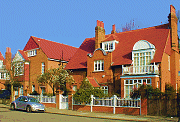|
An influential ‘new model suburb’ created after 1875 in the south-east corner of Acton by the speculator Jonathan
Carr. Prompted by the arrival of the Metropolitan Railway at Turnham Green, Carr bought 24 acres of land with the intention
of building a settlement that would be affordable yet stylish. He named the project after the dukes of Bedford, who owned
property here in the seventeenth century, and commissioned EW Godwin to design the first houses. However, the architectural
press criticised the interiors, though Godwin had previously worked on the Chelsea homes of Wilde and Whistler. Anxious to
avoid damage to the development’s reputation, Carr sacked Godwin and brought in R Norman Shaw, the leading architect
of his day. Shaw’s Queen Anne architecture has been nicknamed ‘Wrenaissance’ – long rows of houses,
some with balconies, differentiated by detailing in the gables, windows and tall chimneys. There was hot water plumbing, and
the airy rooms looked out onto tree-lined avenues. These well-received homes formed the heart of Bedford Park but Shaw resigned
in 1880, frustrated with Carr’s exacting demands and slow bill paying. The next five years’ building was the work
of EJ May, a pupil of Shaw’s, and the differences in the designs represent an evolution rather than a change of direction.
Carr commissioned progressively larger houses with more generous gardens, but his company failed in 1886. The remaining plots
were sold to an assortment of developers and construction continued until the outbreak of the First World War. Unlike many
of the more austere Victorian communities, Bedford Park had an inn, a club and an art school as well as the customary church.
The area suffered a decline during the post-war years, and delays in granting statutory protection allowed several houses
to be demolished and replaced by blocks of flats in the early 1960s.
 |

